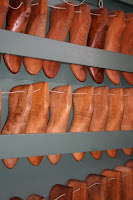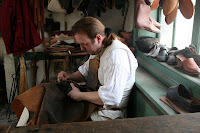This was very interesting to watch. One of the most commonly-practiced trades in 18th-century Virginia, historical shoemaking is preserved at the Shoemaker's Shop, open for visitors today. Techniques are rediscovered in the study of 18th-century shoes and evidence in the shop's apprenticehip program.
The first shoemakers arrived in America at Jamestown in 1610, and the trade was thriving as early as 1616. In 1661, the Virginia Assembly directed that each county must erect one or more tanneries and shoe manufactories. It also imposed tariffs on leather and shoes exported from Virginia to control speculation and profiteering in the local shoe trade, and stipulated that the fees collected go to finance the founding of the College of William and Mary.
Today, the shoemaker's shop in Williamsburg represents the firm of George Wilson, who moved to Williamsburg from Norfolk, Virginia in the late 1760s. In Norfolk, Wilson's sister-in-law was the proprietor of the shoe factory of Mary Wilson and Company. In 1773, George Wilson specialized in "Boots and Shoes for Gentlemen," which he boldly advertised in the Virginia Gazette. Boot making was the most sophisticated and prestigious branch of the trade. Following a centuries-old tradition, the making of boots and shoes for men and the making of shoes for women were separate pursuits.
Wilson's shop competed with between 10 and 12 other Williamsburg shoemakers, all operating in the city at the same dates. Together the local shoemakers struggled with competition from merchants in the colony who imported ready-made shoes from factories in London, Northampton and Bristol in England. In addition, several local wholesale factories mass-produced shoes in Norfolk and Petersburg, Virginia.
When a man came into George Wilson's shop in 1773 to buy a pair of shoes, he selected from a stock of "sale shoes" in popular-styled, already-sized shoes – just like today. If his feet were an unusual size, he could order a pair made to suit his taste and fit his foot. Custom-made shoes required a day's wait. Boots for riding were the specialty of the firm, and Wilson advertised seasonally, offering imported leather and boot legs from London and also offering work for journeymen shoemakers who could make boots.
Various leathers and tools made by specialty trades and imported from England were readily available for sale from merchants' stores in Williamsburg, it was no trouble finding supplies in the city. With strange-sounding names such as "helling sticks," "petty-boys," and "St. Hugh's Bones," a shoemaker's complete tool kit included relatively few items and could be purchased for about the same price as a common pair of shoes – the same as one day's wages for a journeyman shoemaker working for Wilson.
printer in the 140-year-old colony to publish a volume on its beginnings – The History of the First Discovery and Settlement of Virginia by William Stith. Success in the printing business required diversification.
When several lines were done, the compositor set them in wooden cases called galleys. Sometimes woodcuts were added to illustrate notices and advertisements. The galleys were tied with string, gathered and locked in a page-size iron frame, or "chase," and secured to the stone bed of the press. A carriage carried the chase back and forth beneath a pressure plate, or "platen."
A fellow called a "beater" used two wood-handled, wool-stuffed, leather-covered ink balls to spread a mixture of varnish and lampblack evenly on the type. Moistened sheets of paper were laid in a cushioned frame that hinged down on the chase, and the carriage was run in. Mounted on a screw about the size of a man's forearm and operated by a long-handled lever, the platen was lowered by the pressman, or puller.
The Printer & Bindery: The Press powerful in colonial times
Thomas Jefferson's "Ideas on American Freedom" was first printed on Clementina Rind's hand-pulled press.
It was a document Jefferson had drafted at Monticello for the guidance of Virginia's delegates to the Continental Congress. The colony's House of Burgesses considered the composition too radical for official endorsement, but a group of Jefferson's friends persuaded the Widow Rind to issue it as a pamphlet. Thus A Summary View of the Rights of British America appeared in August 1774. The future author of the Declaration of Independence later wrote:
The Printing Office & Post Office on Duke of Gloucester Street. |
"If it had any merit, it was that of first taking our true ground, and that which was afterwards assumed and maintained."
It was just one Revolutionary demonstration of the printer's power to spread incendiary views. But it still may be the most historically important job to come off a Williamsburg press since William Parks set up the first one in 1730.
Parks came from Maryland to do government printing and commercial work. Six years later, he started Virginia's first newspaper. With the advice and investment of Philadelphia's Benjamin Franklin, Parks opened Virginia's first paper mill in 1743. Four years later, he became the first
Each letter had to be set individually on the printing press. |
Parks' double-bay-windowed shop served as a stationer's, a post office, an advertising agency, an office supply shop, a newsstand, and a bookbindery. He sold magazines and books, maps and almanacs,and even sealing wax! His press printed broadsides and business forms, laws and proclamations, tracts and blank record books. In the 20th century, while excavating the site of Parks' shop, archaeologists found lead border ornaments used for French and Indian War currency.
The type is set by hand in a painstaking process. |
When several lines were done, the compositor set them in wooden cases called galleys. Sometimes woodcuts were added to illustrate notices and advertisements. The galleys were tied with string, gathered and locked in a page-size iron frame, or "chase," and secured to the stone bed of the press. A carriage carried the chase back and forth beneath a pressure plate, or "platen."
The printer proofreads a page fresh from the 18th-century |
A compositor gathered type, sorted by letter, size, and kind, from a compartmented box. He set each letter on an iron rule, called a "composing stick," to form words and lines. The type had to be set "backwards," as printing reversed the images.
Each sheet was squeezed against the type under about 200 pounds of pressure to receive its impression, then set aside to dry before the other side was printed. Each impression required about 15 seconds. The workday lasted up to 14 hours.
A bookbinder compiled the signatures and beat them with a heavy hammer to make the sheets lie close. He arranged them on a sewing frame and stitched them together at the back fold with linen thread. As he sewed, he looped the strands around thick hemp cross threads, which created characteristic horizontal ridges across the spine and unified the assembly.
A bookbinder compiled the signatures and beat them with a heavy hammer to make the sheets lie close. He arranged them on a sewing frame and stitched them together at the back fold with linen thread. As he sewed, he looped the strands around thick hemp cross threads, which created characteristic horizontal ridges across the spine and unified the assembly.
Dyed leather was drawn onto boards and glued to heavier endpaper to cover the volume. Sometimes the endpapers were marbled. All of the marbled paper used in Williamsburg seems to have been imported from England, where such work was a craft in itself.
Marbling required a small tank and a mixture of water and a syrupy gum. The marbler dripped vivid watercolors onto the surface and drew special combs across it to create distinctive swirls and eddies. An endpaper was laid on the surface to take up the watercolor, then removed and dried.
The covers of better books were made of fine leather that was tooled, stamped, and decorated with designs sometimes rendered in gold leaf.
In Colonial Williamsburg today, the Printing Office, Post Office, and Bookbindery are located in one shop where press trades are interpreted and authentic reproduction items from Parks' reconstructed shop are offered for sale.








No comments:
Post a Comment